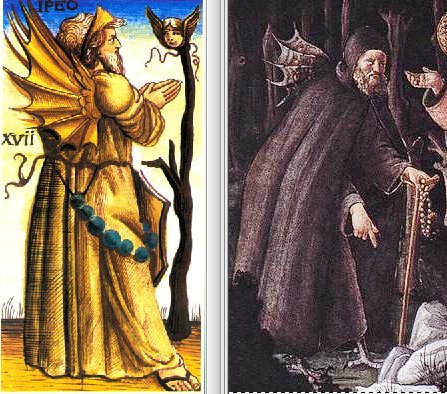Ross wrote, about the comparison of the SB XVII "Ipeo" and the Botticelli image,
I have nothing to add at the moment, except to remind you about the Botticelli image of one of the temptations of Christ in the Sistine Chapel, which we talked about a few years ago at AT -
http://www.tarotforum.net/showthread.ph ... botticelli
(posts 10-14)
You made this comparative image -
There are some caveats though:
- the relevance of the name "Ipeo" remains unexplained
- the context: in Botticelli's fresco, he is clearly the Devil posing as a monk
- no evil-bird feet in the Sola Busca image
- there is no talking stick in Botticelli's image; instead, compositionally, Christ takes his place!
Nevertheless, that talking stick and especially those evil looking bat wings make the Sola Busca Ipeo seem somewhat diabolical.
I think Ross's suggestion is worth saying more about--and Steve's, too.
The connection between "Ipeo" and Botticelli's image is that "Ipeo" is "Typheo" minus the T, and Typheo was considered a Greek version of the Devil. The son of Tartarus and Gaia, he tries to put himself above Zeus, like Lucifer above God, and loses the subsequent battle. Usually Typhon was described as having snakes emanating from his body. For example,
http://www.theoi.com/Gigante/Typhoeus.html has
Antoninus Liberalis, Metamorphoses 28 (trans. Celoria) (Greek mythographer C2nd A.D.) :
"Typhon was the son of Ge (Earth), a deity monstrous because of his strength, and of outlandish appearance. There grew out of him numerous heads and hands and wings, while from his thighs came huge coils of snakes. He emitted all kinds of roars and nothing could resist his might."
The Minchiate Devil card has that feature, the snakes coming from his thighs, as well as wings (see e.g.
http://a-tarot.eu/p/jan-11/viev/ronc-devil.jpg, posted by Bertrand recently). In the SB's Ipeo, the wings are his only devilish attribute, but perhaps that's all we need. In most respects, likewise, the SB figure does not resemble Typhon either.
It strikes me that the figure on the stick might be meant to be a Luciferian Selene. Her wings form a kind of crescent above her head. The Moon, as Hecate, was considered the goddess of witches, with their sabbaths at the full moon. Around his waist, Ipeo wears a medallion of eight discs. These could be the phases of the moon. So we have Typhon in service to Selene, like a devil in service to Lucifer.
But these SB figures are anybody's guess!
About the 2 of Batons, it seems to me that an obese older naked male would more likely have been associated with Dionysus's teacher and companion Silenus, than with either Dionysus or Priapus. In the context of c. 1500 Venice, the most well known one would have been Mantegna's engraving of "drunken Silenus," unbearded (
http://mini-site.louvre.fr/mantegna/acc ... n_6_2.html), made into an engraving by Durer in 1494 (see
http://www.oneonta.edu/faculty/farberas ... n_fig.html, one of the last two images).
(This last link has a good image--relating to the "Ipeo" card--of the female serpent next to the Tree, one by Hugo van der Gross, c. 1470.)
For me the difficulty is that the card has none of the suggestions of a Bacchanalian context that usually accompanied representations of Silenus: no satyrs, no grapes, no cups, no ivy wreaths. (If you do a Google Images search for Silenus, you will see what I mean.) But at some point "Silenus" must have become a standard designation for any older obese naked male, because in the Barcelona Picasso Museum there is his school-drawing of an obese unbearded older naked male with the title "Silenus." (I can't find it on the web--there is just Picasso's version of the Mantegna.) Whether that was so in the time of the SB I don't know.



